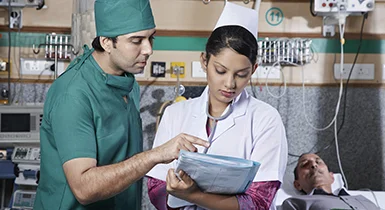An endoscopy is a diagnostic procedure that allows a gastroenterologist to look at the interior lining of the oesophagus, stomach, and the first part of small intestine through a thin, flexible viewing instrument called a flexible endoscope An upper endoscopy is used to diagnose and, sometimes, treat conditions that affect the upper part of your digestive system, including the oesophagus, stomach and beginning of the small intestine (duodenum).
Indications for an endoscopy?
A gastroenterologist may recommend an endoscopy procedure to Investigate digestive signs and symptoms, such as nausea, vomiting, abdominal pain, difficulty swallowing and gastrointestinal bleeding.
Endoscopy is also used to collect tissue samples (biopsy) to test for diseases causing bleeding, inflammation, diarrhea or cancers of the digestive system.
In the procedure for endoscopy a flexible endoscope special instruments can be passes through the endoscope to treat conditions in of digestive system, such as acidity, control of bleeding vessel or assistant in widening a narrow oesophagus due to strictures, removal off a polyp or a foreign object.
Advances in gastrointestinal fibre-optic endoscopic technology have made endoscopy mandatory for gastrointestinal diagnosis, therapy, and endoscopy surgery.
An endoscopy is sometimes combined with other procedures, such as an ultrasound to view organs.
What is the Endoscopy procedure?
During an upper endoscopy process the patient will be asked to lie down on a table on his back or on his side. Sedation will be given for an anaesthetic will be sprayed in the mouth to numb the throat. The flexible endoscope which is a long, flexible tube (endoscope) is inserted in the mouth.
The doctor will ask the patient to swallow as the flexible endoscope scope passes down the throat and it then enters down your oesophagus. A tiny camera at the tip of the endoscope transmits images to a video monitor in the exam room. In the endoscopy procedure a gastroenterologist watches the images on a monitor to look for abnormalities in your upper digestive tract. Air pressure may be fed into the oesophagus to inflate the digestive tract which allows the endoscope to move freely, during the endoscopy procedure.
In cases of a surgical endoscope special surgical instruments are passes through the endoscope to collect a tissue sample or remove a polyp.
What is a fluoroscopy?
Fluoroscopy is a diagnostic procedure used to view moving body structures .A continuous X-ray beam is passed through the body p being examined. . It enables a radiologist enables to view body skeletal, digestive, urinary, respiratory, and reproductive systems. Fluoroscopy is used as an imaging procedure to evaluate specific areas of the body, including the bones, muscles, and joints, as well as solid organs, such as the heart, lung, or kidneys.
Some other procedures where fluoroscopy is used as a supportive imaging tool is in fluoroscopy is as barium X-rays, cardiac catheterization, arthrography to visualize joints of a joint , lumbar puncture, placement of intravenous (IV) catheters), intravenous pyelogram, hysterosalpingogram, and biopsies.
What is the procedure of fluoroscopy?
During the Fluoroscopy procedure a contrast substance (dye) is injected through an intravenous (IV) line in the hand or arm swallowed, or enema. The patient is positioned on the X-ray table. Depending on the type of procedure, a specific body part will viewed. The patient will be asked to hold his breath at intervals while the fluoroscopy is being performed. A special X-ray machine will be used to produce the fluoroscopic images of the body structure being examined or treated
What is Endoscopic retrograde cholangiopancreatography (ERCP?)
Endoscopic retrograde cholangiopancreatography (ERCP) is a medical and diagnostic procedure that combines the use of endoscopy and fluoroscopy to diagnose and treat certain problems of the biliary or pancreatic ductal systems. .
The most common condition for advising an ERCP medical procedure is abdominal pain, weight loss, jaundice (yellowing of the skin), or an ultrasound or CT scan that shows stones or a mass in the pancreatic biliary duct system.
Diagnosis of Bile duct stones can be diagnosed and removed with an ERCP procedure.
Stretch out narrow segments in bile ducts due to strictures.
Diagnosis of tumours can be diagnosis. ERCP can also be done before or after gallbladder surgery.
If you have any queries regarding any of these procedures or indications, please contact our centres at Wockhardt hospital.
Wockhardt Hospitals, a chain of tertiary care super-specialty hospitals has more than 25 years of experience in the creation and management of Super Specialty Hospitals in India.
We are a premiere hospital in the country specializing in the treatment of digestive disorders. We provide comprehensive digestive care to our patients. The digestive care centre at Wockhardt Hospitals makes it a centre for excellence with our clinical expertise, to treat such conditions affecting the digestive system. For further information or any gastroenterology medical related query visit our experts at Wockhardt Hospital.
Wockhardt Hospitals is regarded as a centre of excellence the healthcare domain, having facilities in North Mumbai (Mira road), South Mumbai (Mumbai Central), Navi Mumbai (Vashi), Nagpur, Nasik, Rajkot and Surat. Wockhardt Hospitals has state-of-the-art infrastructure. Our prime objective is patient safety and quality of care at all levels. The guiding philosophy is to serve and enrich the Quality of Life of patients and to make life win.




